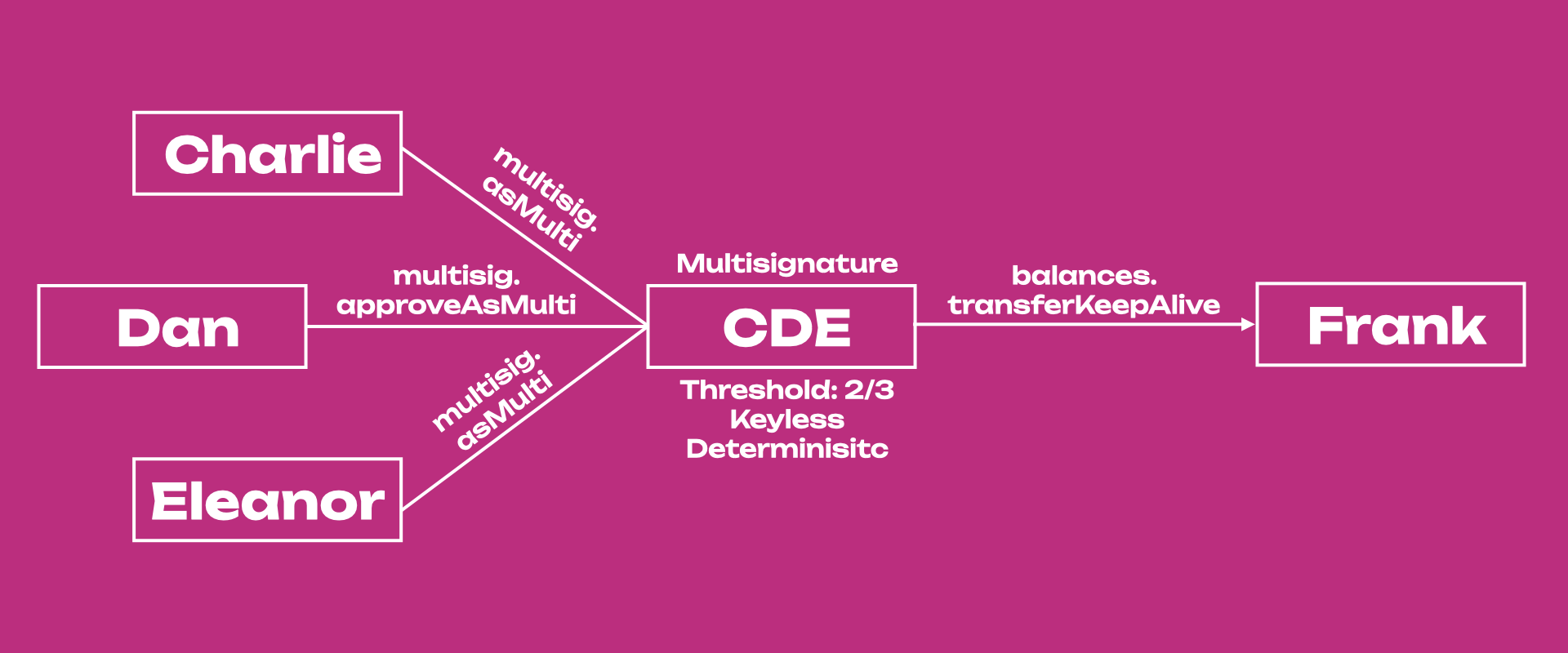Polkadot-JS Guides about Multi-signature Accounts
Creating a Multisig Account
Check the "How to create a multisig account" section on this support page. We recommend trying out the tutorial on Westend network - Polkadot's testnet.
Multisig Transactions with Accounts Tab
See this video tutorial to learn how to transact with a multisig account using the Accounts Tab in the Polkadot-JS UI.
You can create a multisig account directly on the Accounts Tab of the Polkadot-JS UI, and use this account to send funds. See this support article for more information.
Multisig Transactions with Extrinsic Tab
See the video tutorial below to learn about multi-signature accounts and how you can transact with them using the Polkadot-JS UI.
There are three types of actions you can take with a multisig account:
- Executing a call
asMulti. This is used to begin or end a multisig transaction. - Approving a call
approveAsMulti. This is used to approve an extrinsic and pass-on to the next signatory (see example below for more information). - Cancelling a call
cancelAsMulti.
Check out this page for more information about the actions you can take with a multi-signature account.
In scenarios where only a single approval is needed, a convenience method as_multi_threshold_1
should be used. This function takes only the other signatories and the raw call as arguments. Note
that the Polkadot-JS UI does not have integration for this call because it is not possible to create
multisig accounts with threshold=1. If you want to create a multisig with threshold 1, you can use
txwrapper-core, which is developed and supported by
Parity Technologies. There is a detailed
multisig example
that you can try out and change to see how it works.
However, in anything but the simple one approval case, you will likely need more than one of the signatories to approve the call before finally executing it.
Multisig Call Deposit
When you create a new multi-sig call, you will need to place a deposit. The deposit stays locked until the call is executed. This deposit is to establish an economic cost on the storage space that the multisig call takes up in the chain state and discourage users from creating multisig calls that never get executed. The deposit will be reserved in the call initiator's account.
The deposit is dependent on the threshold parameter and is calculated as follows:
Deposit = depositBase + threshold * depositFactor
Where depositBase and
depositFactor are chain constants set
in the runtime code.
The other signatory accounts should have enough funds to pay for the transaction fees associated with approving the multisig call. The deposit is for the call; that is, other signatories will not need to place additional deposits. Once the multisig call is executed or rejected, the deposit is released on the account that initiated the call.
Example using Multisig Accounts
See this video tutorial to learn how to transact with a multisig account using the Extrinsic Tab in the Polkadot-JS UI.

Let's consider an example of a multisig on Polkadot with a threshold of 2 and 3 signers: Charlie,
Dan, and Eleanor. First, Charlie will create the call on-chain by calling the multisig.asMulti
extrinsic with the raw call, in this case, a balance transfer (balances.transferKeepAlive
extrinsic) from multisig CDE to Frank's account. When doing this, Charlie will have to deposit
DepositBase + (2 * DepositFactor) = 20.152 DOT while he waits for either Dan or Eleanor also to
approve the balance transfer call using the multisig.approveAsMulti or the multisig.asMulti
extrinsics.
If Dan submits the multisig.approveAsMulti extrinsic, he approves Charlie's call but he passes on
the final approval to Eleanor. So, although the multisig has threshold 2, in this case all 3/3
signatories need to participate in the transaction approval. Eleanor will need to submit a
multisig.asMulti or multisig.approveAsMulti extrinsic to transfer funds from CDE to Frank.
Alternatively, Dan or Eleanor can just submit a multisig.asMulti extrinsic after Charlie to
transfer the funds. In this case, 2/3 signatories will participate in the transaction approval. The
accounts approving Charlie's call will not need to place the deposit, and Charlie will receive his
deposit back once the transfer is successful or canceled. To cancel the transaction, Dan or Eleanor
can use the multisig.cancelAsMulti extrinsic.
Note that multisigs are deterministic, which means that multisig addresses are generated from the addresses of signers and the threshold of the multisig wallet. No matter the order of the signatories' accounts, the multisig will always have the same address because accounts' addresses are sorted in ascending order.
Public keys of signers' wallets are compared byte-for-byte and sorted ascending before being used to
generate the multisig address. For example, consider the scenario with three addresses, A, B, and C,
starting with 5FUGT, 5HMfS, and 5GhKJ. If we build the ABC multisig with the accounts in that
specific order (i.e. first A, then B, and C), the real order of the accounts in the multisig will be
ACB. If, in the Extrinsic tab, we initiate a multisig call with C, the order of the other
signatories will be first A, then B. If we put first B, then A, the transaction will fail.
This has some implications when using the Extrinsics tab on the Polkadot-JS UI to perform multisig transactions. If the order of the other signatories is wrong, the transaction will fail. This does not happen if the multisig is executed directly from the Accounts tab (recommended). The Polkadot-JS UI supports multisig accounts, as documented on the Account Generation page. You can see our video tutorials for more information about creating multisig accounts and transacting with them using both the Accounts Tab and the Extrinsic Tab in the Polkadot-JS UI.
Decoding Multisig Call Data
Before signing a transaction, it is important to know the exact specifics of what is being signed. Check the "How to use a multisig account" in the support docs on how to decode the multisig call data.
